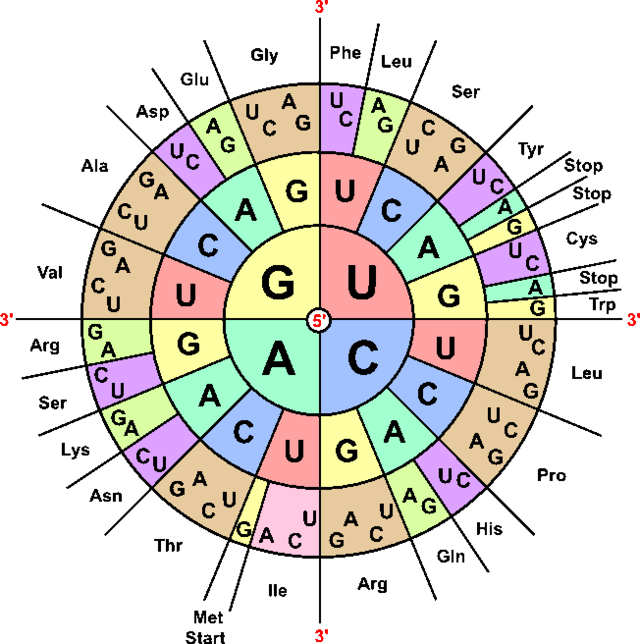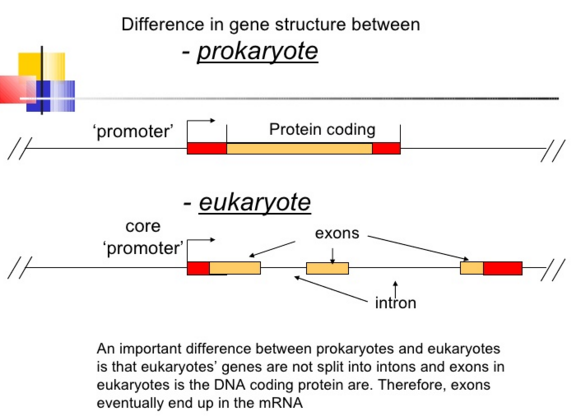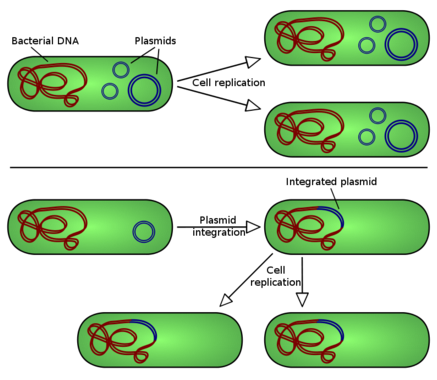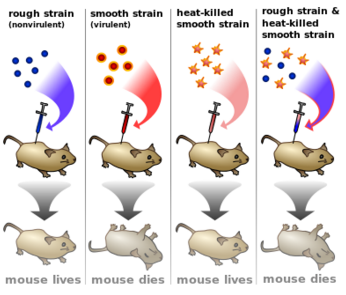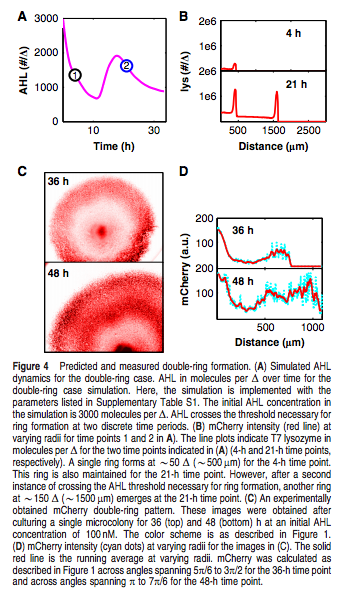Co-Lab Open Science School
From Wikicliki
- All living organisms reproduce themselves by transmitting genetic information to their progeny. The cell is the minimal self-reproducing unit.
- prokaryotes vs eukaryotes
- prokaryote: a prokaryote is a single-celled organism that lacks a membrane-bound nucleus (karyon), mitochondria, or any other membrane-bound organelle.
- eukaryote: a eukaryote is any organism whose cells contain a nucleus and other organelles enclosed within membranes.
- You are composed of many cells. You begin with one single egg cell.
- All cells stores their hereditary info in the same linear chemical code (DNA)
- All cells transcribe portions of their hereditary information into the same intermediary form (RNA)
- Ribonucleic acid (RNA) is a polymeric molecule implicated in various biological roles in coding, decoding, regulation, and expression of genes. RNA and DNA are nucleic acids, and, along with proteins and carbohydrates, constitute the three major macromolecules essential for all known forms of life.
- http://genius.com/Igem-paris-bettencourt-team-how-to-build-an-igem-team-annotated
- http://genius.com/artists/Igem-paris-bettencourt-team
- http://genius.com/Igem-paris-bettencourt-team-what-is-the-central-dogma-of-biology-annotated
- All cells use proteins as catalysts
- All cells translate RNA into protein in the same way
The translation of genetic information from the 4-letter alphabet of polynucleotides into the 20-letter alphabet of proteins is a complex process. The rules of this translation seem in some respects neat and rational, in other respects strangely arbitrary, given that they are (with minor exceptions) identical in all living things. These arbitrary features, it is thought, reflect frozen accidents in the early history of life chance properties of the earliest organisms that were passed on by heredity and have become so deeply embedded in the constitution of all living cells that they cannot be changed without wrecking cell organization.
- "Its just a bit of a GTCA": https://www.youtube.com/watch?v=CQEaX3MiDow
- Exercise: make a list of letters - GCTA.
- What is a gene? The fragment of generic information corresponding to one protein is one gene. A gene is a distinct sequence of nucleotides forming part of a chromosome, the order of which determines the order of monomers in a polypeptide or nucleic acid molecule which a cell (or virus) may synthesize.
- RNA also have a large role in the functioning of the cell. RNA interference (RNAi) is a biological process in which RNA molecules inhibit gene expression, typically by causing the destruction of specific mRNA molecules. Viruses like HIV has a double strand. Almost all double strands (rare) are bad or virus or alien things that will kill cells. They cut everything and destroy similar things to itself. It is a tool used to kill RNA molecules that is similar to it. You can make it to do experiments.
- All cells function as biochemical factories dealing with the same basic molecular building blocks
Contents
How to write DNA?
- We use plasmids in bacteria
- Artificially constructed plasmids may be used as vectors in genetic engineering. These plasmids serve as important tools in genetics and biotechnology labs, where they are commonly used to clone and amplify (make many copies of) or express particular genes
- Transforming Bacteria - Frederick Griffith - "transforming principle" - The transforming principle was an early name for DNA. In 1928, scientists didn't know yet that DNA carried genetic information, but they knew that there was something that could cause bacteria to transform from one type to another. Transformation occurs when one bacterium picks up free-floating DNA, and incorporates it into its own genome.
- See more on Griffith's Experiment, morton mandel and akiko higa (1970)
- Gene drive - https://en.wikipedia.org/wiki/Gene_drive
Workshop
Discussion - Ideas from the class
- children as dna containers. but what if we put dna into other containers
- great decay
- way of changing algae into building material
- producing molecular machines which are inside the body - the machines scan dna and make warnings for cancer cells and stop cancer cells from multiplying - recycling environment
- serotonin recorders?
- recreating a feeling / memories / binary code
- pacman - synbio creatures which eats more synbio creatures (the woman who swallowed a fly... then swallowed a spider to eat the fly...)
Digressions...
- What were those letters behind my profile in 23andme? Mitochondrial DNA haplogroups M7b1'2. Googled it - It doesn't have anything to do with DNA specifically after all. A haplogroup is a genetic population group of people who share a common ancestor on the patrilineal or matrilineal line. Haplogroups are assigned letters of the alphabet, and refinements consist of additional number and letter combinations. Mitochondrial DNA haplogroups M7b1'2 - http://www.ncbi.nlm.nih.gov/pubmed/19026397
Singapore - approval process for GMO / synbio
- http://www.gmac.gov.sg/Index_Singapore_Biosafety_Guidelines_for_Research_on_GMOs.html
- http://www.gmac.gov.sg/pdf/Appendix3_Flowchart.pdf
Discussion
- http://ginkgobioworks.com/ - makes designer rose culture aromatics
- http://www.fastcoexist.com/3039743/the-quest-to-reproduce-the-scent-of-a-rose-with-designer-microbes
- bacteria which lives on different levels of oxygenation
- A table which changes colour based on the shadows of objects previously placed on to it?
- Bacteria which changes with light
Bacterial Patterns
- Turing Patterns
- http://www.scholarpedia.org/article/Gierer-Meinhardt_model
- https://en.wikipedia.org/wiki/Truchet_tiles
- Microbial Pet - Feed your Microbial Pet made from your DNA???
- Microbial Memorial
- Microbial Sculpture
- Microbial Graffiti?
- Could you trace something's history/location by analysing its microbiome?
- Why aren't there lists of promoters?
- http://www.cambia.org/daisy/promoters/271/273.html
Serial Cloner / Visualising
- Download Serial Cloner.
- Tetraselmis subcordiformis transgenic GFP (gfp) gene, complete cds; chloroplast
- Press FASTA, copy the code
- https://lifeware.inria.fr/~batt/workshop_2015/program.html
- http://molbiol-tools.ca/molecular_biology_freeware.htm
- Perhaps a visual example helps more... this looks good: http://angularplasmid.vixis.com/about.php
- http://www.cambia.org/daisy/promoters/271/273.html
- http://www.snapgene.com/products/snapgene_viewer/
- http://www.rcsb.org/pdb/home/home.do
Ideas
- 100 years from now, we will look back at microbial experiments generated by iGem and other syn bio interests in a museum full of absurd, failed microbial arts.
Final Presentation
- Room Mate Agreement - Common Bacterial Repository - consent and community - bacterial bank at home which you grind over your food
- meat fish aversion - veggies
- clean house - sneeze when you are in contact with dust
- same sleep time - regular sleep cycle - engineered carpet microbiota make inhabitants sleepy at same time
- Engineering the Shower - microbial community housing
- carpets - fungi dermatophyte - add terbinafine. no engineered bacteria. stops athlete's food and ringworm.
- curtain - methylobacteria - part of human foot microflora. contribute to pink color of biofilm. --> perfume curtain? add natural spieces of algae, cyanobacteria, dinoflagellates, vibrio fisheri or other naturally fluoreseent bacteria.
- tiles -aspergillus niger - black mould on onion, potato, used to produce vit c
- shower head - mycobacterium spp (avius)
- grout - replacing grout with natural organism based grout with live algae
- http://www.ncbi.nlm.nih.gov/pubmed/15240300
- Bacterial dialogues - sound
- Plant gene responses to frequency-specific sound signals - http://link.springer.com/article/10.1007%2Fs11032-007-9122-x
- Production of sound waves by bacterial cells and the response of bacterial cells to sound. - http://www.ncbi.nlm.nih.gov/pubmed/12501293

